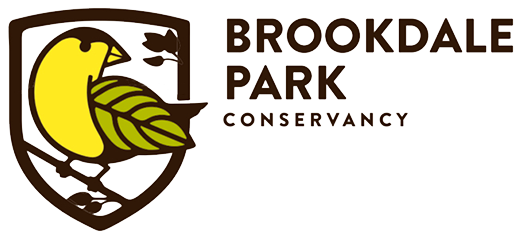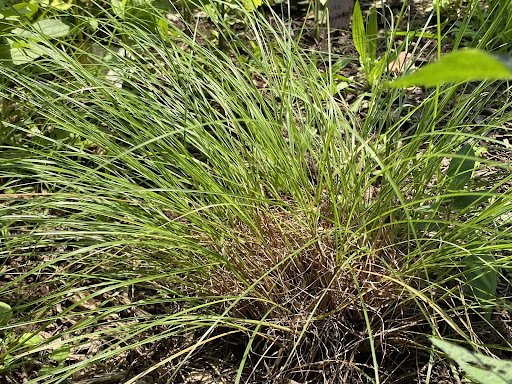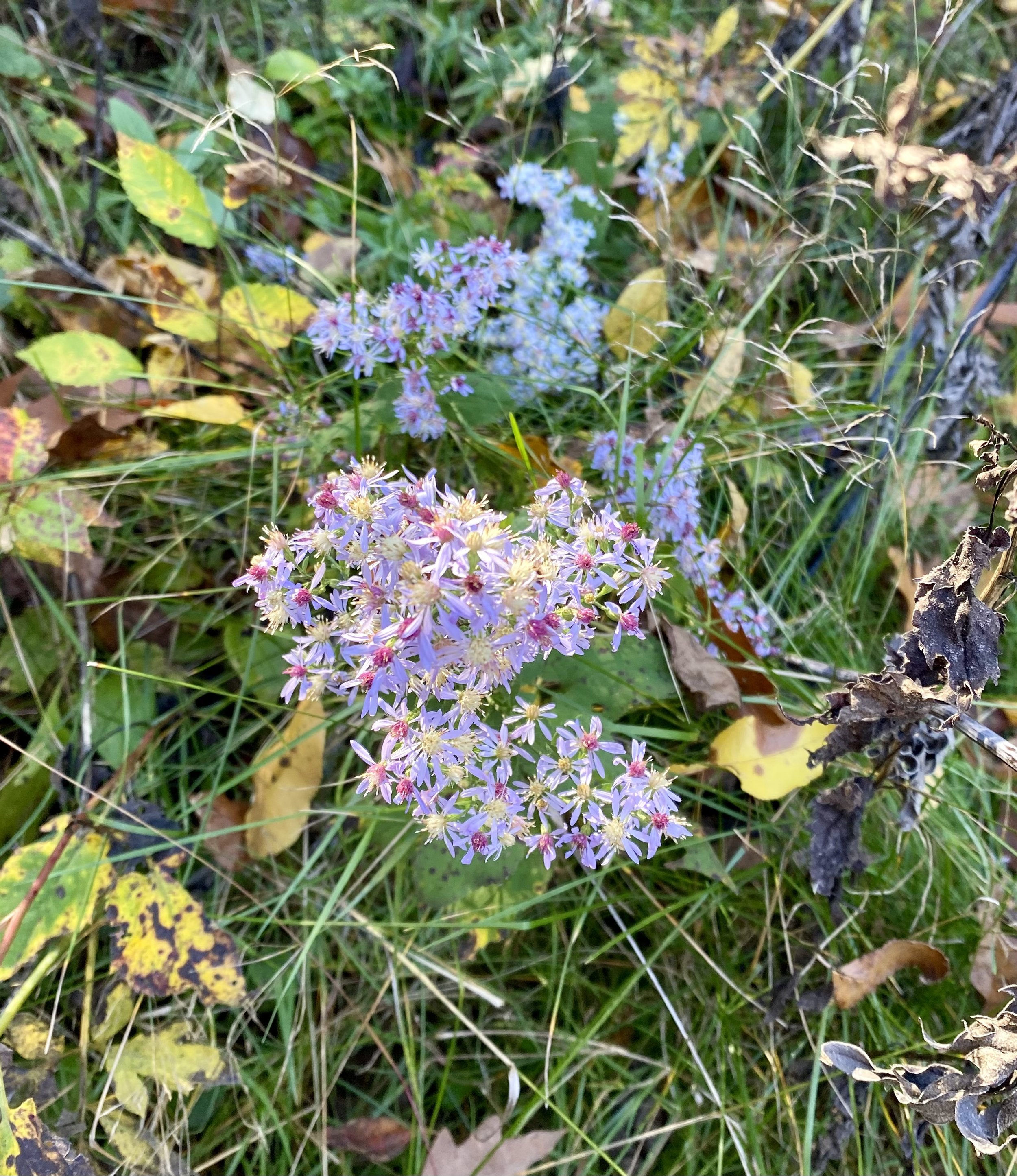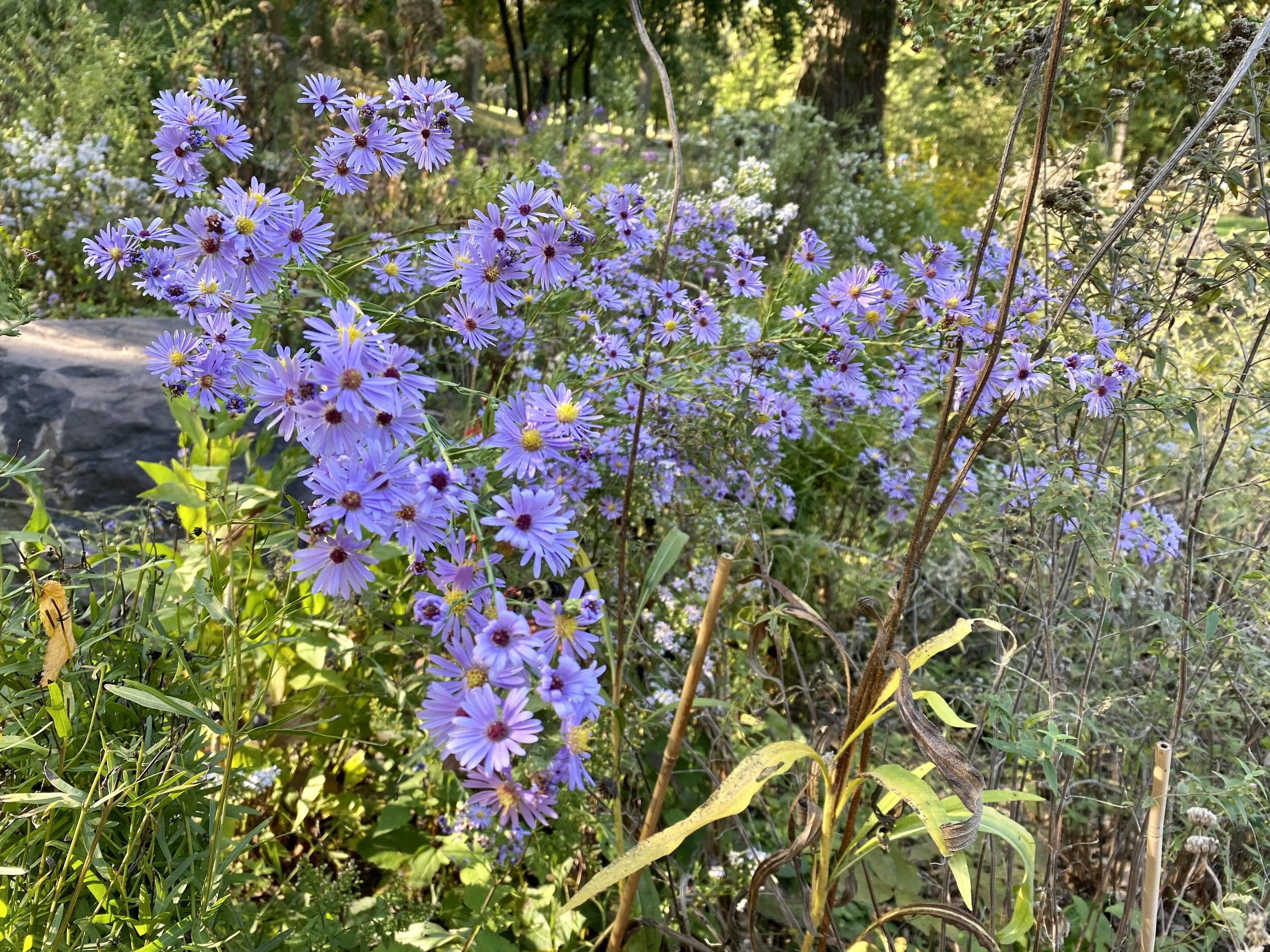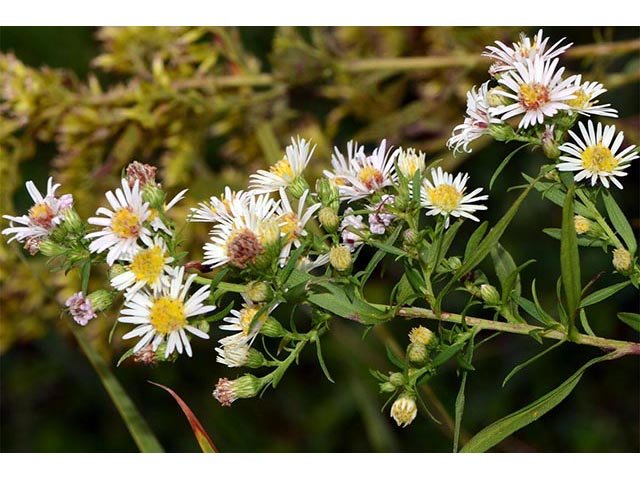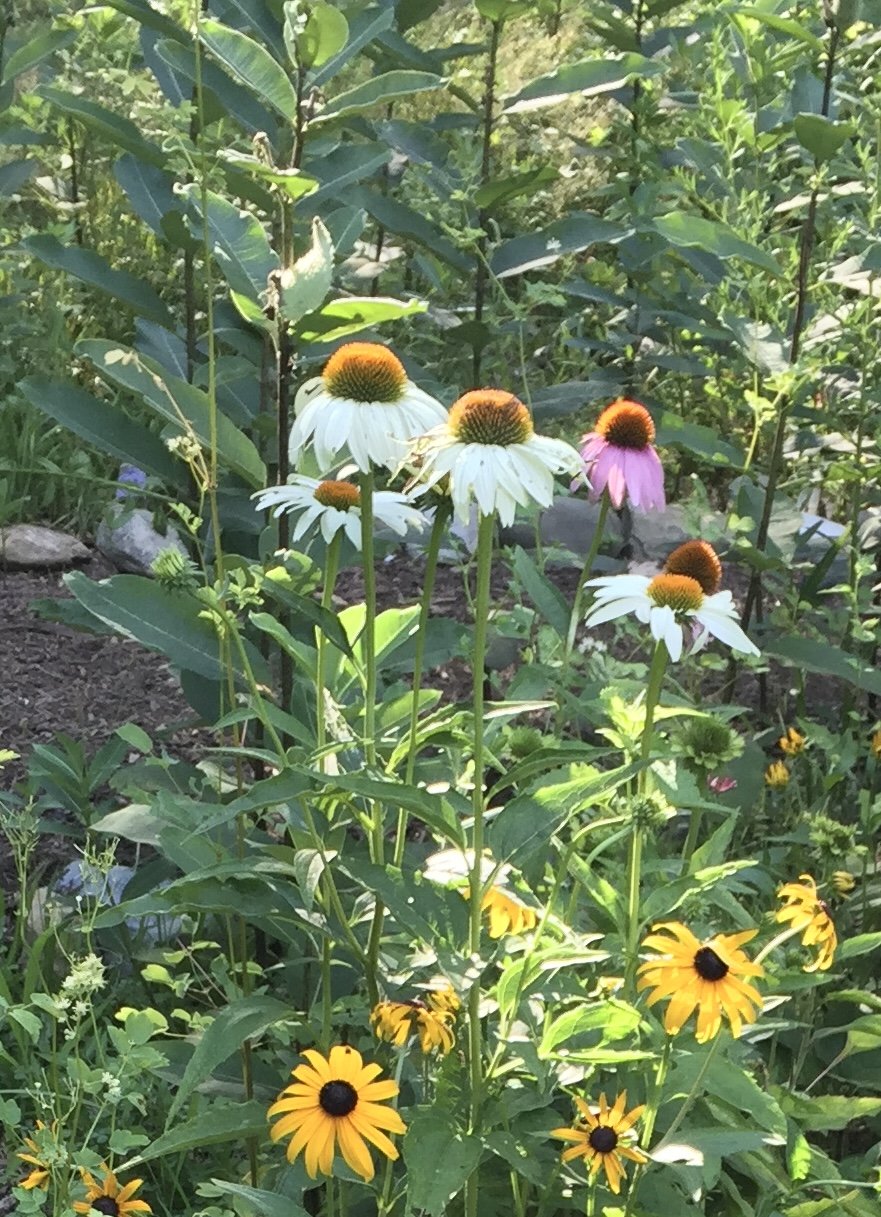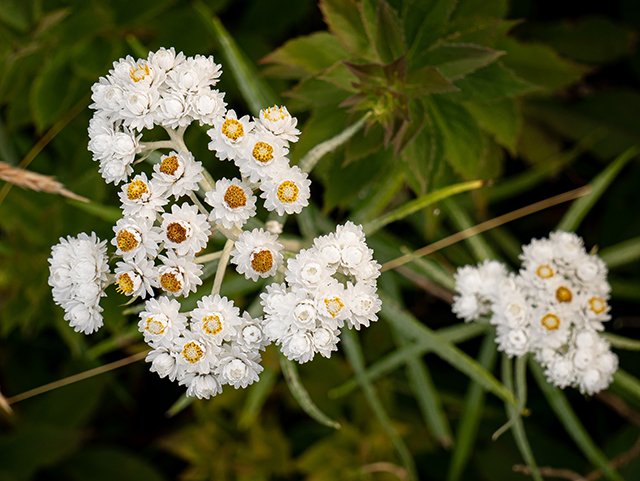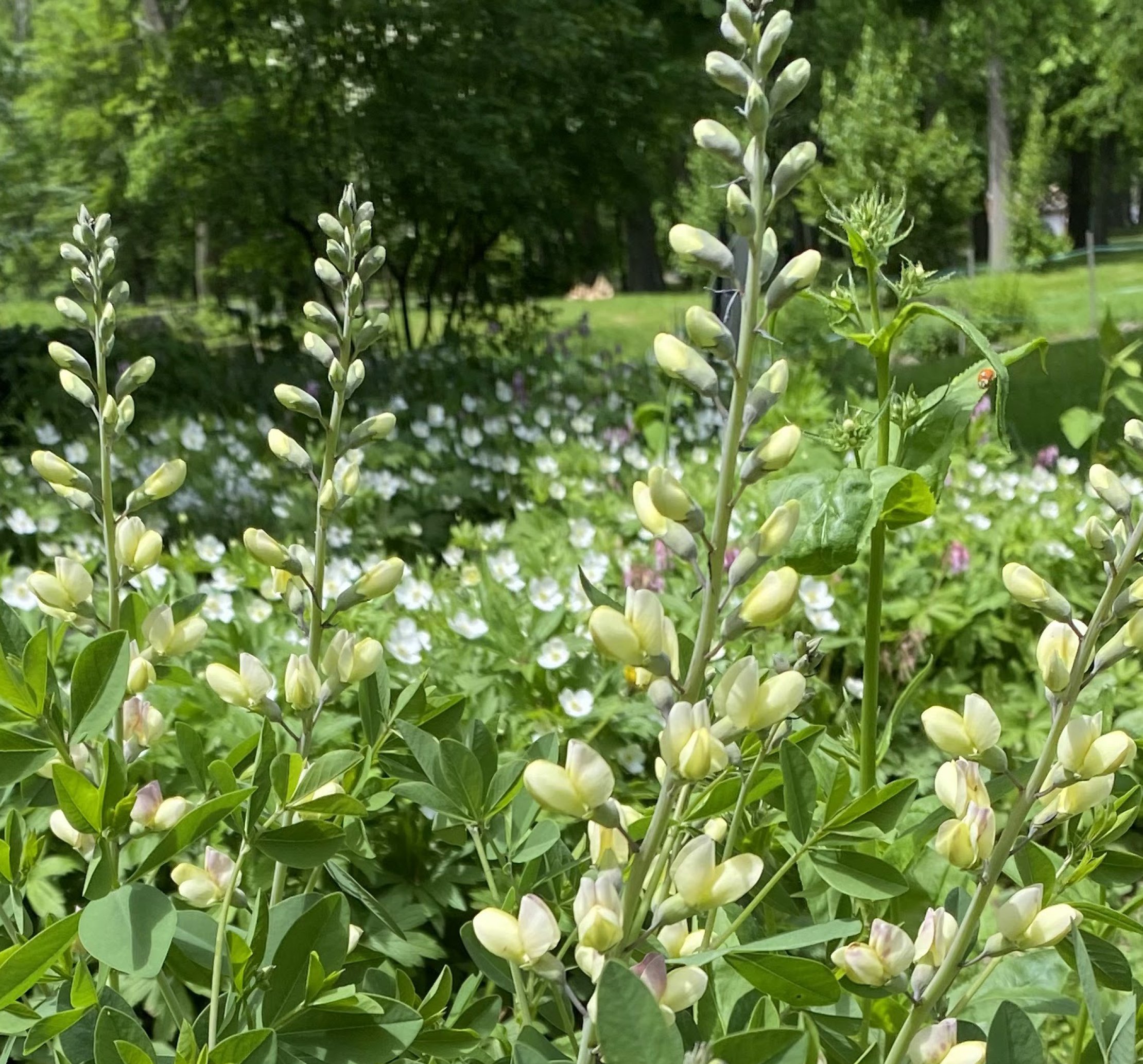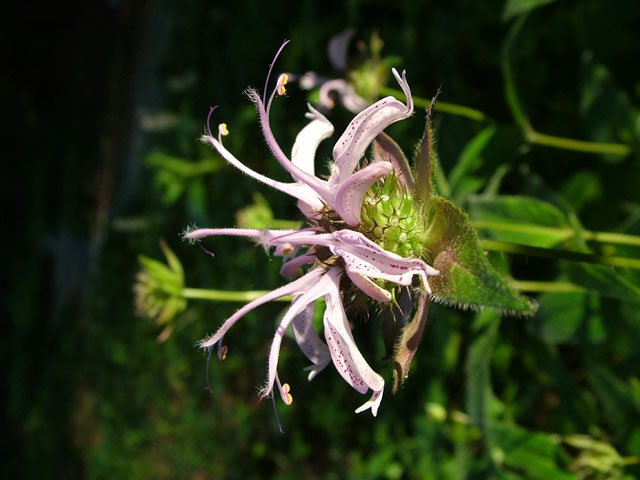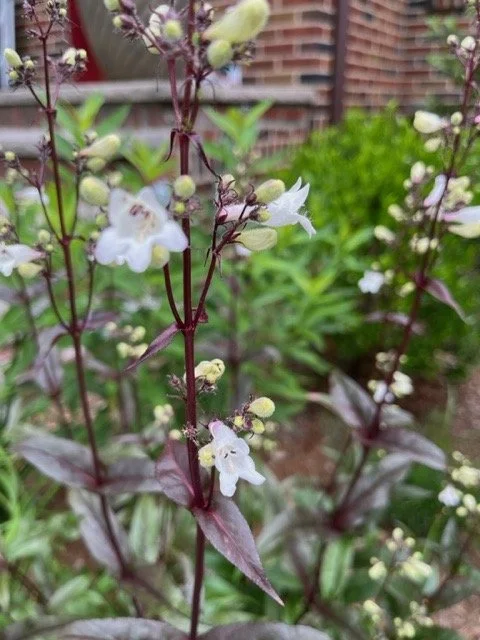Pollinator Patch
LITTLE BLUESTEM
Schizachyrium scoparium
This ornamental grass gets its name from the blueish color of the base leaf blades in spring. In fall it turns reddish brown which lasts through winter. Small birds love their silvery-white seeds. This plant is best suited for a meadow, a border in masses or as an accent.
Attracts: birds, butterflies, Skippers spotted in PP
Growth: Grass, 2-3’ h, sun, tolerates all soil types, likes dry, drought tolerant, some deer resistance
Blooms: Mid to late summer
Location: Pollinator Patch, Milkweed slope
PRAiRIE DROPSEED
Sporobolus heterolepis
An ornamental grass with thin leaves that form round tufts. Fragrant pink flowers bloom in mid-late summer. By fall the leaves turn golden brown. Bees like to build nests in it. Birds love the seeds. It’s great for a pollinator garden or as an accent plant.
Attracts: bees, birds, butterflies, skippers spotted in the park
Growth: Grass, 1-2’ h, sun, tolerates all soil types, likes dry, drought tolerant, some deer resistance.
Blooms: Mid to late summer
Location: Pollinator Patch
PURPLE LOVEGRASS
Eragrostis spectabilis
A good choice for hot, dry, drought conditions. This warm-season grass has small reddish purple flowers that bloom in mid to late summer and appear airy, almost floating above the foliage. Use en masse as a border or in a meadow.
Attracts: Butterflies, birds
Growth: Grass, 1-2’ h, sun, likes moist sandy soil, deer resistant.
Blooms: Mid to late summer
Location: Pollinator Patch
BLUE WOOD ASTER
Symphyotrichum cordifolium
This late-blooming (late summer-fall) perennial is a much needed nectar source for pollinators in fall. The flowers are a mix of blues and purples. Cutting back the flowers in mid-July will create bushier plants and will prevent it from falling over.
Attracts: Butterflies including the Pearl Crescent seen at the garden
Growth: Perennial, 2-4’, full sun to part shade, tolerates all soil types but prefers moist, rich soils,
Location: Every part of the garden
ASTER, NEW ENGLAND - purple, lavender, pink, & white forms
Symphyotrichum novae-angliae
Large and showy flowers that bloom in late summer into fall. Prune mid-summer to encourage bushiness and to prevent from flopping over. Pairs nicely with goldenrod. It thrives best in moist meadows and woodland’s edge.
Attracts: Butterflies, moths, bees and birds. Host plant to the Pearl Crescent Butterfly
Growth: Perennial, 3-5’ h, Partial sun, moist soil
Location: Pollinator Patch, Milkweed slope
SMOOTH ASTER
Symphyotrichum laeve
This low-maintenance herbaceous perennial bursts with blueish lavender flowers in late summer-fall. The leaves feel smooth to the touch hence its common name. Excellent pick for a pollinator garden.
Attracts: Butterflies, Host plant to the Pearl Crescent Butterfly
Growth: 1-4’, Full sun, tolerates soil of all types, drought tolerant
Location: Pollinator Patch
Courtesy James L. Reveal, Lady Bird Johnson Wildflower Center.
ASTER, TALL WHITE
Symphyotrichum lanceolatum
Many of us treat this like a weed, but it produces attractive flowers well into the fall and feeds scores of wildlife. Insects, birds and mammals all find tasty food here - Wild Turkeys eat the seeds and leaves, sparrows eat the seeds and deer and rabbits eat the foliage. If you have it in the garden you will enjoy its cheery flowers and all its visitors.
Hosts: Pearl Crescent Butterfly
Growth: perennial, 1-4” h, partial sun, moist soil
Bloom: August - October
Location: Pollinator Patch
Courtesy Thomas L. Muller, Lady Bird Johnson Wildflower Center.
ASTER, WHITE WOOD
Eurybia divaricata
This aster, like its cousins, blooms late summer providing color into the fall. It is a nectar source for butterflies and works well in shady borders, or as an understory (herb layer) in a woody area. Plant it in masses to maximize the show.
Attracts: Butterflies Hosts: Pearl Crescent Butterfly
Growth: perennial, 1-2’ h, shade, tolerates dry soil
Bloom: August - October
Location: Pollinator Patch, Shady Slope
BLUE MIST FLOWER
Conoclinium coelestinum
The compact clusters of blueish white flowers bloom from mid summer until frost. It is an important food source for native bees. In the home garden cutting it back in the middle of the summer will make it bushier. It spreads by rhizomes and will need dividing to keep it in check.
Attracts: Native Bees, butterflies Hosts: Lined Ruby Tiger Moth
Growth: perennial, 1-2’ h, full sun/part shade, dry/moist soil
Bloom: August - October
Location: Pollinator Patch, Milkweed Slope, Woodland Garden
BONESET, LATE FLOWERING
Eupatorium serotinum
Used by early settlers and Native Americans as a medicine, its name comes from being used to treat “breakbone” or dengue fever. In the home garden this provides a cool white flower in the heat of summer.
Attracts: bees, wasps, flies, moths, butterflies
Growth: perennial, 2-4’ h, part/full sun, loamy rich moist soil,
Bloom: August - October
Location: Pollinator Patch
BLAZING STAR, DENSE
Liatris spicata
This plant has dense spikes of flowers that bloom from the top down, setting it apart from other spike flowers which tend to bloom from the bottom up. They are best suited in a pollinator garden or border in masses or scattered as an accent.
Attracts: Hummingbirds, Bees, Butterflies
Growth: perennial, 2-3’ h, sun, tolerates all soil types, deer resistant
Bloom: May - July
Location: Pollinator Patch
BLAZING STAR, ROUGH
Liatris aspera
This blazing star blooms in the hottest time of the year and has fewer flowers on its spike than other Liatris. The flowers are pollinated by insects with long tongues that can reach the bottom of the tubular flowers. The corms (base of the stems) are a favorite food for rodents - especially voles. A vivid addition to the back of a border.
Attracts: Bees, Butterflies, other insects, Hosts: Flower Moths
Growth: perennial, 2-3’ h, sun, multiple types of soil
Bloom: August - Sept
Location: Pollinator Patch, Milkweed Slope
Bower, Virgin’s, Woodbine
Clematis virginiana
This plant grows rapidly and is one of the few vines that will readily flower in shade, you can prune it aggressively any time of year. The showy fragrant flowers particularly on the male plant delight in the fall - but - be warned that left untamed this will overwhelm landscape shrubs and the plant is toxic. Contact dermatitis can occur, and if eaten the leaves, flowers and sap is toxic to pets. In humans it can cause mouth pain, ulcers, dizziness, convulsions, and fainting.
Attracts: hummingbirds, bees
Growth: vine, 15-20’long, full to part sun or deep shade, well drained moist soil
Bloom: Fall
Location: Pollinator Patch
Photo credit A. Cressler, Wildflower Center Digital Library
Coneflower, Orange
Rudbeckia fulgida
This perennial with its big showy yellow-orange flowers and long bloom time is easy to grow. Leave the seed heads and watch goldfinches swaying in the wind while eating seeds. Plant in masses.
Attracts: Birds bees
Growth: 2-3’h, Sun, moist soil of all types
Blooms: July-October
Location: Pollinator Patch, Milkweed Slope
Coneflower, Pale
Echinacia pallida
The distinct characteristic of this coneflower is its thin, drooping pale purple petals. It blooms a few weeks earlier than the more common purple coneflower and has a long lasting bloom time.
Attracts: Bees, butterflies, birds
Growth: 2-4’h, Sun/part shade, tolerates range of moisture
Blooms: May-July
Location: Pollinator Patch. Milkweed Slope
Coneflower, Purple
Echinacea purpurea
A popular flower for the home garden for its showy, long-lasting blooms. The flowers of echinacea plants are used to make a tea to boost the body’s immune system.
Attracts: Bees, butterflies, birds
Growth: 1-3’h, Sun/Part-shade, adaptable to most soil types
Blooms: May-August
Location: Pollinator Patch
Coneflower, White
Echinacea purpurea ‘pow wow’
Like the popular Purple Coneflower, this white-petaled cultivar has a long bloom time and looks great en masse in a garden especially in a wildflower garden. It self seeds each year leaving many to spare as cut flowers.
Attracts: Bees, butterflies, birds
Growth: 1-3’ h, Sun/Part-shade, adaptable to most soil types
Blooms: May-August
Location: Pollinator Patch
Coreopsis, Prairie
Coreopsis palmata
This bright yellow flower is easy to grow. It readily self seeds so perfect for a wildflower garden, meadow or an area you are trying to naturalize.
Attracts: Bees, Butterflies
Growth: 1-3’ h, Sun, adaptable to most soil types, heat, humidity and drought tolerate
Blooms: May-July
Location: Pollinator Patch
Everlasting, Pearly
Anaphalis margaritacea
Native Americans used this herb for a variety of medicinal purposes from treating sore and rheumatism or smoking it as a cold treatment. Providing a cool note late in the season’s sunny border the clusters of tiny aster-like flowers are showy and can also be included in dried flower bouquets.
Attracts: bees, butterflies
Host: Painted Lady Butterflies
Growth: perennial, 1-3’h, full sun/part shade, well drained loamy/sandy soil
Bloom: late summer
Location: Pollinator Patch
photo credit: S Brundage, Wildflower Center Digital Library
GOLDENROD, Wrinkleleaf
Solidago rugosa
This goldenrod grows to an average of 4 ft tall and is compact, making it a solid performer in a late fall border - pair it with asters for a garden spectacle. Its pollen is a source of food for butterflies and bees in the fall months as they prepare to hibernate or migrate. Multiple bee species specialize in eating only this plant’s pollen, even as they collect nectar from other flowers.
Attracts: Bees, butterflies, birds
Host: Wavy-lined emerald larvae, several species of bees eat only solidago nectar
Growth: perennial, 2’-5’ h full/part sun, moist/damp soil
Bloom: Fall
Location: Pollinator Patch
GOLDENROD, “volunteer species”
Solidago X
Every year we are not quite sure which new species of goldenrod might have planted itself for us - but we and our insect visitors certainly enjoy the late season color and nectar these plants provide.
Attracts: bees and migrating butterflies
Growth: perennial, 2-4’, sun/part shade, dry soil
Bloom: Sept-Oct
Location: Pollinator Patch
HAREBELLS
Campanula rotundifolia
First year seedlings will not bloom, but after that the plants will bloom for months as long as you take off the spent flowers. It is easily cultivated and will spread nicely in a border.
Attracts: native bees, hummingbirds
Growth: perennial, 1-1.5’, part shade, organic sandy soil
Bloom: May-August
Location: Pollinator Patch
HYSSOP, ANISE
Agastache foeniculum
Hyssop does it all, blooms for months, is good as fresh or dried cut flowers, has leaves that smell great, can be used for tea, provides rich nectar to wildlife and works well in your garden. You might think of having it in a pot by your entrance, so that it will greet you with flowers and scent as you brush by.
Attracts: bees, butterflies, hummingbirds.
Growth perennial, 2-4’h, sun/part shade, dry soil, high deer resistance
Bloom: June-August
Location: Pollinator Patch
BLUE FALSE INDIGO
Baptisia Australis
Wild and bushy this plant has black seedpods that rattle with the wind - a good plant for a sensory garden. It was used to make a natural dye and the stems with pods can be used in dried flower arrangements. Plant it in the back of a border for a striking accent.
Attracts: bees. Host: Wild Indigo Duskywing Butterfly Growth perennial, 2-4’ h, full sun/partial shade, dry soil
Bloom: May-June
Location: Pollinator Patch
FALSE INDIGO var PINK LEMONADE
Baptisia Cultivar
This plant is a variety bred from the native plant. Soft yellow flowers age to dusty raspberry purple, with both colors appearing at the same time. The tall charcoal stems really make the colors pop.
Attracts: bees. Host: Wild Indigo Duskywing Butterfly
Growth: perennial, 3-4’ h, full sun/partial shade, dry soil
Bloom: May-June
Location: Pollinator Patch
IRONWEED, NEW YORK
Vernonia noveboracensis
Ironweed offers glorious, tall flowers in late summer that would compliment a stand of asters or offer a contrast to the yellow of late summer goldenrods. This will self-seed with great delight!
Attracts: Bees, Butterflies, Birds for seeds
Growth: perennial, up to 8’, full sun, many soil types
Bloom: Aug-Sept
Location: Pollinator Patch, Milkweed Slope
JOE PYE WEED, HOLLOW-STEM
Eutrochium fistulosum
In the back of your border this tall plant will provide 3 season interest - a strong dark green accent in spring, clusters of pink/rose flowers in summer, airy seed heads in winter. The seeds are an important food source for sparrows in the winter.
Attracts:Butterflies and honeybees, Host: Three lined Flower Moth, Eupatorium Borer Moth, Clymene Moth
Growth perennial, 6-8’, sun, moist fertile soil
Bloom: July-Aug
Location: Pollinator Patch
JOE PYE WEED, Spotted
Eutrochium maculatum
Also known as Queen of the Meadow, this is a great plant in a wet border; loaded with flowers that provide abundant food for wildlife. It can look scorched if the soil dries out so it is best suited for a wetter area.
Attracts: butterflies, bees, song birds Host plant: Eupatorium Borer Moth
Growth: perennial, 4-6’ h, sun/part shade, clay/loam moist soil
Bloom: July-August
Location: Pollinator Patch
MALLOW, Crimson-eyed
Hibiscus moscheutos
The grayish green leaves and white flowers of the mallow provide a cool note in the heat of summer in the garden. The plant will bloom all summer until the first frost. This can look stunning alone as a spot light or in the border.
Attracts: Hummingbirds, Host plant: Painted Lady Butterfly, Io Moth
Growth: perennial, 4’, sun/part shade, moist loam soil
Bloom: July-September
Location: Pollinator Patch
MEADOW RUE, Tall
Thalictrum pubescens
There is much to like on this plant, the gigantic height is a contrast to dancing clouds of tiny flowers and delicate columbine-like leaves. Its exuberance will stop you in your tracks and you will enjoy the pollinators and birds that are attracted to it. It is easy to see why it is also called King of the Meadow.
Attracts: butterflies and bees
Growth: perennial, 6-8’, part to full shade, organically rich moist soil
Bloom: May-July
Location: Pollinator Patch
MILKWEED, Butterfly
Asclepius tuberosa
All milkweeds are essential to Monarch butterflies because eating milkweed leaves makes the caterpillars and adult butterflies toxic to birds and other predators. Butterfly milkweed enhances a home garden, holding its own with ornamentals and non native plants. Its long lasting orange flowers are followed by decorative seed pods. A drought tolerant stunner!
Attracts: Bees, Butterflies, Hummingbirds Host plant: Monarch, Queen and Gray Hairstreak Butterflies
Growth: perennial, 2-4’, full sun, most dry soils
Bloom: May-August
Location: Pollinator Patch
MILKWEED, Common
Asclepius syriaca
Milkweed’s unique flower supports a complicated pollination strategy. First, a visitor’s leg accidentally falls into a crevice in the flower, when it’s extracted a pollen sack attaches to the leg. Milkweeds bank on the insect then going to another milkweed flower, accidentally getting its leg caught again and leaving the pollen sack behind. Orchids have a similar pollination strategy - more details can be found here
Attracts: Bees, Butterflies, Hummingbirds Host plant: Monarch Butterfly
Growth: perennial, -4+’h, sun/part shade, all soil types
Bloom: May-June
Location: Entire Garden
MILKWEED, Swamp
Asclepius incarnata
This milkweed prefers wet areas and can do well in rain gardens. It also will do well in a butterfly garden if it is not allowed to dry out. Its lovely pink flowers will blend in well in your garden and the seed heads can be used in dried flower arrangements.
Attracts: Bees, Butterflies, Hummingbirds Host plant: Monarch Butterfly and Queen Butterfly
Growth: perennial, 2-4’ h, sun/part shade, well drained wet soil
Bloom: May-August
Location: Pollinator Patch
Courtesy James L. Reveal, Lady Bird Johnson Wildflower Center.
MONARDA, Wild Bergamot
Monarda fistulosa l.
This monarda’s showy flowers are as at home in a butterfly or native garden as in a traditional border. These flowers are visited by hummingbirds, once they find the flower in your yard they tend to come back daily. While monarda can get powdery mildew this does not harm the plant or others in the border and seems a small price to pay for hummingbird visits!
Attracts: Hummingbirds, song birds, bees, butterflies
Growth: perennial, 3-4’, sun/part shade , dry soil
Bloom: May-July
Location: Milkweed Slope, Pollinator Patch
Courtesy Stefan Bloodworth, Lady Bird Johnson Wildflower Center.
Monarda, Bradbury
Monarda bradburiana
Also known as bee balm, this plant will tolerate poor soil and has aromatic leaves that may be used for tea. If deadheaded its bloom time will be prolonged. It is a vigorous self seeder but it is easy to identify and control its spread.
Attracts: Bees, Hummingbirds, Butterflies
Growth: perennial, 2’ h, sun/part shade, dry to medium soil
Bloom: May-June
Location: Pollinator Patch
Monarda, Magenta
Monarda didyma ‘Magenta’
This tall monarda stands stiffly above the other plants in the garden. Red bee balm is particularly attractive to hummingbirds, butterflies and bees. After the bloom period has passed song birds are attracted to the seed heads. Water from below and allow the plant air to keep powdery mildew at bay.
Attracts: Bees, Hummingbirds, Butterflies
Growth: perennial, 3-4’h, sun, moist soil
Bloom: May-July
Location: Pollinator Patch
Mountain Mint, Hairy
Pycnanthemum verticillatum var pilosum
Mountain mint shimmers in the garden due to its silvery leaves, its flowers are small, and its seed capsules provide winter interest. It contains pulegone which smells like spearmint, repels mosquitos and deters deer. In the garden it looks best behind a lower plant.
Attracts: Bees, butterflies, beneficial wasps Hosts: Stink Bug
Growth: perennial, 3-4’h, sun/part shade, well drained clay/loam
Bloom: May-August
Location: Pollinator Patch
Penstemon, Husker Red
Penstemon digitalis ‘Husker Red’
This is a cultivated variety with darker foliage than it’s native cousins. It produces lots of flowers and spreads in the garden. The scientific genus penstemon comes from the Greek words pent (five) and stamon (stamen) referring to the fact the flower has 5 stamens. Digitalis refers to finger as the flowers look like fingers of a glove.
Attracts: Hummingbirds, butterflies
Growth: perennial, 3-4’ h, sun, well drained soil avoid overly wet areas
Bloom: April-May
Location: Pollinator Patch
Courtesy R. W. Smith, Lady Bird Johnson Wildflower Center.
Penstemon, Tall White
Penstemon digitalis
This plant is also called Foxglove Beardtongue, referring to the glove finger shape of the flower and a long hairy filament that often protrudes from that flower. It looks great in naturalized areas of your yard, or at the back of a border.
Attracts: Bees, Hummingbirds, Butterflies
Growth: perennial, 2-3’ h, sun, well drained soil
Bloom: April-June
Location: Pollinator Patch
Petunia, Wild
Ruellia humilis
Each flower blooms for one day, but is rapidly replaced by a new crop of flowers in the morning. Wild petunia can be used as a low growing ground cover, or in the front of a garden bed and will self seed readily. In combination with violets you would get ground cover that blooms spring to almost the end of summer.
Attracts: Hummingbirds, bees Hosts: Common Buckeye and White Peacock Butterflies
Growth: perennial, 1-1.5’h, sun, dry sandy or well drained soil
Bloom: May-July
Location: Pollinator Patch
Courtesy W.D. and Dolphia Bransford, Lady Bird Johnson Wildflower Center.
Primrose, Common Evening
Oenothera biennis
This plant has a 2-year lifecycle. In the first year it produces a rosette of leaves (8-16” wide) without flowers. The second year brings on the flower stalk with yellow flowers that open at dusk. The flowers smell lemony and are fertilized by night flying moths or early morning bees. All parts of this plant including the roots were eaten by Native Americans.
Attracts: Moths, bees Hosts: Primrose Moth
Growth: biennial, 4-6’h, sun, well drained soil
Bloom: June-September
Location: Pollinator Patch, Milkweed Slope
Courtesy Robert L. Stone, Lady Bird Johnson Wildflower Center.
Rattlesnake Master
Eryngium yuccifollium
The common name refers to its use in the 1700s for preventing and treating snake bites, but there is no proof of its efficacy. The scientific name describes the long (up to 30”) fibrous leaves that form at the base of this plant. Today this plant and its cultivated varieties are increasingly used as an ornamental plant.
Attracts: wasps, bees, butterflies, flies Hosts: Rattlesnake Master Stem-borer, Seed Eating Moth
Growth: perennial, 4’h, sun, moist soils
Bloom: June-August
Location: Pollinator Patch, Milkweed Slope
Sage, Blue
Salvia azurea
Cutting this plant back by half in late spring will keep the stems from drooping; dead heading and providing regular moisture may help produce a second bloom period. The light blue flowers contrast nicely with the yellows of the late summer garden.
Attracts: bees and butterflies. Host: Hermit Sphinx Moth
Growth: perennial, 3-4’h, sun, well-drained, moist soil
Bloom: August-September
Location: Pollinator Patch
Snakeroot, White
Ageratina altissima
As one of the latest blooming flowers its nectar is important for bees, butterflies and moths preparing to overwinter or migrate. The milk from cows that eat this plant can cause vomiting, tremors, liver failure and death. Abraham Lincoln’s mother is thought to have died from this “milk sickness”.
Attracts: bees and butterflies,
Growth: perennial, 1-3’h, part shade, moist rich soil
Bloom: August-October
Location: All areas
Spiderwort, Ohio
Tradescantia ohiensis
The 3-petaled flowers last for just one day but are an attractive blue; combined with the erect stems and grassy leaves this is a nice native addition to your garden. The nectar is of special value to bumblebees.
Attracts: native bees
Growth: perennial, 2-3’h, sun, most soils
Bloom: April-May
Location: Pollinator Patch
Sunflower, Downy
Helianthus mollis
These bright yellow flowers will follow the path of the sun each day . Goldfinches love the seeds - in the fall you find them going from stem to stem to feed. These plants do best when planted amongst others that can protect them from the wind.
Attracts: birds, butterflies
Growth: perennial, 3-4’h, sun, well-drained soil
Bloom: June-August
Location: Pollinator Patch
Vervain, Blue
Verbena hastata
Its tall spikes that carry flowers which bloom a few at a time make it an attractive plant in moist areas of the garden. The fact that it attracts a rich variety of visitors and butterfly/moth larvae means that you will have plenty of activity to observe.
Attracts: butterflies and birds Host plant: Common Buckeye Butterfly
Growth: perennial, 3’h, sun, most soils
Bloom: April-June
Location: Pollinator Patch
annuals
Cosmos
Cosmos x
These delicate flower saucers dance on thin stems with fine leaves in a range of colors. This annual is a nice addition to the garden as an accent and a way to attract pollinators, which is why we it is here even if it is not native.
Attracts: pollinators and butterflies
Growth: annual, 3-4’h, sun/part sun, well-drained soil
Bloom: June-September
Location: Pollinator Patch
Mexican Sunflowers
Tithonia x
Native to Mexico and Central America these plants provide vivid color in the garden and are very attractive for pollinators. Adding these to your garden will create a richer mix of visitors.
Attracts: butterflies, bees, hummingbirds
Growth: annual, 3-4’h, sun, poor, well-drained soil
Bloom: July-October
Location: Pollinator Patch
Courtesy Al Braden, Lady Bird Johnson Wildflower Center.
Sunflowers
Helianthus annuus
We are experimenting in 2023 with growing these native flowers in the garden. The tall plants will attract wildlife to your yard, are simple to grow, and are effective in the landscape to screen a fence, side of a driveway or garage etc.
Attracts bees, birds, butterflies
Growth: annual 3-15’, sun, dry soils
Bloom: July-August
Location: Pollinator Patch
Zinnias
Zinnia x
These are native to Mexico but as a rich source of food they have space in our garden and are constantly abuzz with visitors. Zinnia are wonderful to grow with children; the seed germinates readily right in your garden, they grow a rainbow of colors, and flowers last for weeks in a vase. While they self seed they are distinctive and easy to control.
Attracts: butterflies, hummingbirds
Growth: annual, 3-4’h, full sun, most soils
Bloom: July-October
Location: Pollinator Patch, Milkweed Slope
shrubs & vines
Blueberry, Highbush
Vaccinium corymbosum
This bush is “buzz pollinated” just like the Shooting Star. Pollination by bees is what brings you the delicious blueberries. Nesting birds come by and pick the bushes clean to feed their babies and later will return as a family group. In the fall the brightly colored leaves are glorious.
Attracts: bees, butterflies, birds Host plant: Spring/Summer Azure Butterfly, Striped Hairstreak Butterfly
Growth: shrub, 2-4+’h, sun/part sun, dry soil
Bloom: May
Location: Pollinator Patch, Milkweed Slope
Dutchman’s Pipe - Pipevine
Aristolochia macrophylla
The heart-shaped leaves of this vine are up to 12 inches long frequently hiding the much smaller yellow green pipe shaped flowers. Using this in the garden requires thought: its high flammability rating means you should not bring it close to your house. Also it is not edible as all parts are toxic to human kidneys.
Attracts: butterflies Host plant: Pipevine Swallowtail Butterfly
Growth: vine, up to 20’ long, part shade, moist rich soil
Bloom: Spring
Location: Pollinator Patch, Woodland Garden, Shady Slop
Poison Ivy, Eastern
Toxicodendron radicans
Poison ivy can be on a tree, bush or or on the ground. “Leaves of three let it be” is wise advice! The middle leaflet is longer than the two side leaflets. Leaves can be glossy or dull, smooth-edged or toothed. The itch/burn takes between 12 hours and 5 days to develop. You can also be irritated from clothes and other items that touched the ivy. It is best to take care and avoid it. Rutgers has advice to address it in your yard.
Growth: vine, 20+’ l, grows in most soil/light conditions
Bloom: Spring
Location: entire garden
